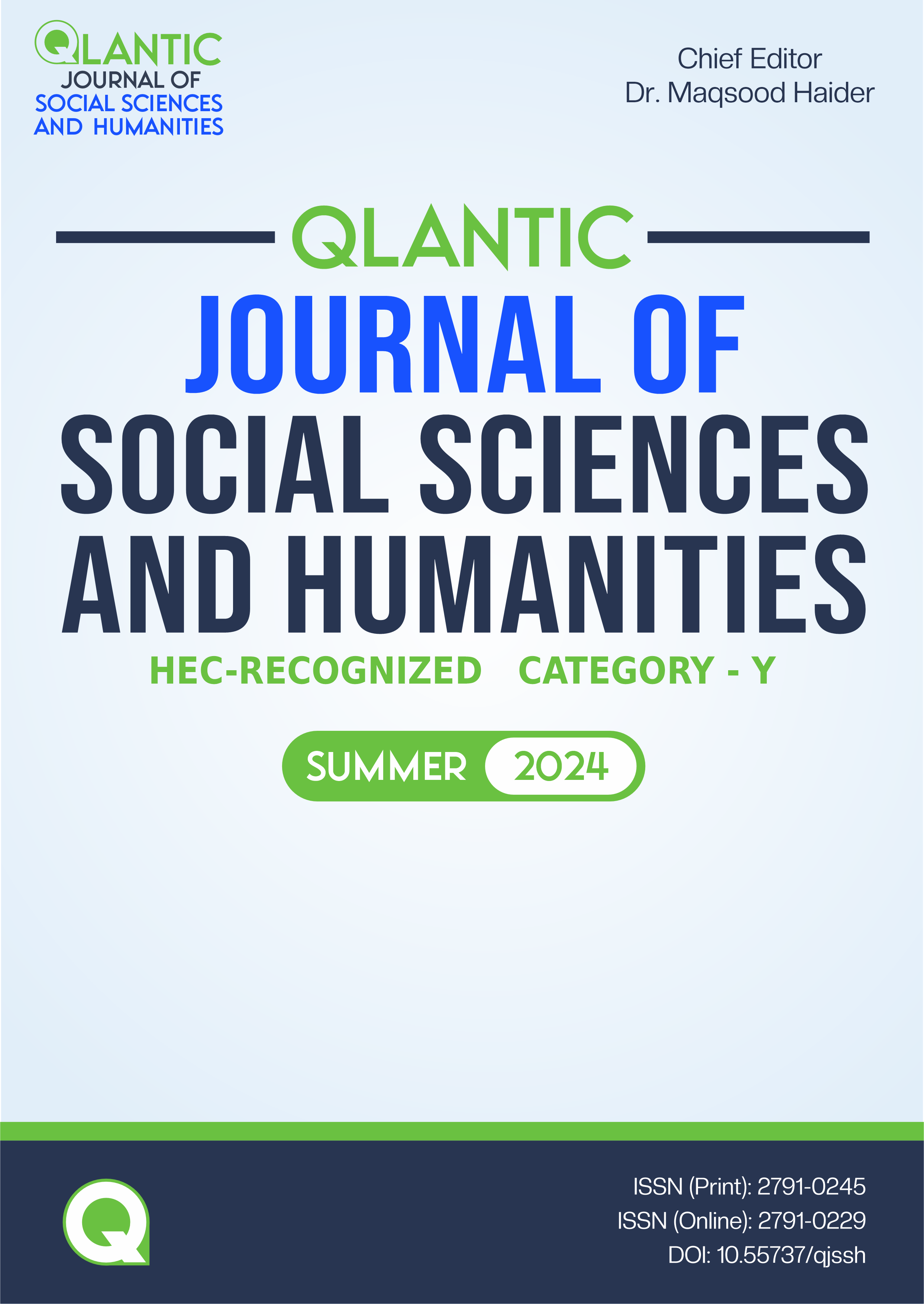Managing Classroom Practices Involved in English Pronunciation Instruction
DOI:
https://doi.org/10.55737/qjssh.363997487Keywords:
Teaching Practices, Pronunciation, Teaching and Learning, Communication, LanguageAbstract
The primary goal of teaching and learning English is to enable students to communicate effectively. This study analyzed the English teachers’ own practices in pronunciation instruction. The study was descriptive in nature, and the target population consisted of higher secondary school English teachers at District Kotli. A sample of thirty teachers was considered for data collection. A semi-structured interview was designed in light of research objectives and questions. Simple random techniques were used for this study. For data collection, the researcher personally visited schools in the district Kotli AJ&K with the prior permission of the concerned administration. It was found that teachers have great classroom teaching practices for clear and consistent pronunciation. Providing feedback and correction is crucial for students' progress; regular practice and repetition are important to improve pronunciation skills. It was concluded that teachers possessed a solid foundation in language instruction, but they neglected to appropriately implement these strategies in their classroom instruction. It is recommended that English language learning be made easier for students by encouraging perfect context in the English books, integrating technology, and utilizing pronunciation apps or online tools for additional practice.
References
Abercrombie, S., Hushman, C. J., & Carbonneau, K. J. (2019). The influence of timing of peer cooperation on learning. Educational Psychology, 39(7), 881–899. https://doi.org/10.1080/01443410.2019.1567690
Afrifa-Yamoah, D., Mr, Kyei, E., Mr, Adubofour, I., Mr, & Sarpong, F. (2021). Challenges students encounter in their study of pronunciation in Ghana: A case of Osei Kyeretwie Senior High School. East African Journal of Education and Social Sciences, 2(2), 120-126. https://doi.org/10.46606/EAJESS2021V02I02.0082
Al-Azzawi, M. B., & Barany, L. K. S. (2016). Teaching Pronunciation: Revisited. SSRN Electronic Journal, 6(4). https://doi.org/10.2139/ssrn.2843935
Alghazo, S. M. (2015). Advanced EFL learners' beliefs about pronunciation teaching. International Education Studies, 8(11), 63-76. http://dx.doi.org/10.5539/ies.v8n11p63
Ali, Z., & Bhaskar, Sb. (2016). Basic Statistical Tools in Research and Data Analysis. Indian Journal of Anaesthesia, 60(9), 662. NCBI. https://doi.org/10.4103/0019-5049.190623
Arifin, A., Dr. Suryaningsih, S. S., & Arifudin, O. (2024). The Relationship Between Classroom Environment, Teacher Professional Development, and Student Academic Performance in Secondary Education. International Education Trend Issues, 2(2), 151–159. https://doi.org/10.56442/ieti.v2i2.467
Baker, A. (2013). Exploring Teachers’ Knowledge of Second Language Pronunciation Techniques: Teacher Cognitions, Observed Classroom Practices, and Student Perceptions. TESOL Quarterly, 48(1), 136–163. https://doi.org/10.1002/tesq.99
Basturkmen, H. (2012). Review of research into the correspondence between language teachers’ stated beliefs and practices. System, 40(2), 282–295. https://doi.org/10.1016/j.system.2012.05.001
Bell, A., Ward, P., Tamal, Md. E. H., & Killilea, M. (2019). Correction to: Assessing recall bias and measurement error in high-frequency social data collection for human-environment research. Population and Environment, 40(3), 346–346. https://doi.org/10.1007/s11111-019-00316-7
Burri, M. (2023). Comparing L2 Teachers’ Practices With Learners’ Perceptions of English Pronunciation Teaching. Profile: Issues in Teachers’ Professional Development, 25(1), 129–145. https://doi.org/10.15446/profile.v25n1.101156
Clapper, T. C. (2010). Creating a Safe learning environment. Pailal Newsletter, 3(2), 1-6.
Cohen, L., Manion, L., & Morrison, K. (2017). Validity and reliability. In Research Methods in Education (pp. 245-284). Routledge.
Field, J. (2005). Intelligibility and the Listener: The Role of Lexical Stress. TESOL Quarterly, 39(3), 399. http://dx.doi.org/10.2307/3588487
Foote, J. A., Trofimovich, P., Collins, L., & Urzúa, F. S. (2013). Pronunciation teaching practices in communicative second language classes. The Language Learning Journal, 44(2), 181–196. https://doi.org/10.1080/09571736.2013.784345
Gay, L. R., Mills, G. E., & Airasian, P. (2012). Educational research: Competencies for analysis. Florida International University. https://books.google.com.pk/books/about/Educational_Research.html?id=J5eJVwEACAAJ&redir_esc=y
Hismanoglu, M., & Hismanoglu, S. (2010). Language teachers’ preferences of pronunciation teaching techniques: traditional or modern? Procedia-Social and Behavioral Sciences, 2(2), 983-989. http://dx.doi.org/10.1016/j.sbspro.2010.03.138
Imran, M., Almusharraf, N., Sayed Abdellatif, M., & Ghaffar, A. (2024). Teachers’ perspectives on effective English language teaching practices at the elementary level: A phenomenological study. Heliyon, 10(8), e29175. https://doi.org/10.1016/j.heliyon.2024.e29175
Ismail, M., Khatibi, A., & Azam, S. M. F. (2022). Impact of school culture on school effectiveness in government schools in Maldives. Participatory Educational Research, 9(2), 261–279. https://doi.org/10.17275/per.22.39.9.2
Kalsoom. (2009). Teaching grammar: Relationship between English language teachers’ beliefs and practices [Master Dissertation]. Institute of education and research, University of the Punjab, Lahore.
Kaseem, S., Yousuf, M. I., Ehsan, T., & Babar, G. H. (2024). Teaching practices for English pronunciation among higher secondary students at District Kotli. International Journal of Social Science Archives, 7(2), 59-69. https://www.ijssa.com/index.php/ijssa/article/view/265/196
Nguyen, L., & Burri, M. (2024). Pronunciation pedagogy in English as a foreign language teacher programs in Vietnam. International Review of Applied Linguistics in Language Teaching, 62(2), 675-691. http://dx.doi.org/10.1515/iral-2022-0126
Shahzadi, N., & Afzal, T. (2024). Relationship between mentoring of English language public secondary school teachers and their classroom practices in Punjab. Pakistan Journal of Society, Education, and Language. 10(2), 203-212. https://pjsel.jehanf.com/index.php/journal/article/view/1394/1005
Tegnered, A., & Rentner, J. (2021). Teachers’ views on teaching English pronunciation: A phenomenographic study of upper-secondary teachers’ views and reported practices [Master’s thesis] Department of Culture and Society, Linköping University, Sweden.
Uchida, Y., & Sugimoto, J. (2018). A survey of pronunciation instruction by Japanese teachers of English: Phonetic knowledge and teaching practice. Journal of the Tokyo University of Marine Science and Technology, 14, 65-75. http://id.nii.ac.jp/1342/00001503/
Vančová, H. (2019). Current Issues in Pronunciation Teaching to Non-Native Learners of English. Journal of Language and Cultural Education, 7(2), 140–155. https://doi.org/10.2478/jolace-2019-0015
Wang, Y. B., & Lee, L. S. (2012, March). Improved approaches of modeling and detecting error patterns with empirical analysis for computer-aided pronunciation training. In 2012 IEEE International Conference on Acoustics, Speech and Signal Processing [ICASSP] (pp. 5049-5052). https://doi.org/10.1109/icassp.2012.6289055
Published
Issue
Section
License
Copyright (c) -1 Samia Qaseem, Mahjabeen Babar, Memoona Khalid, Dr. M. Imran Yousuf

This work is licensed under a Creative Commons Attribution-NonCommercial 4.0 International License.





